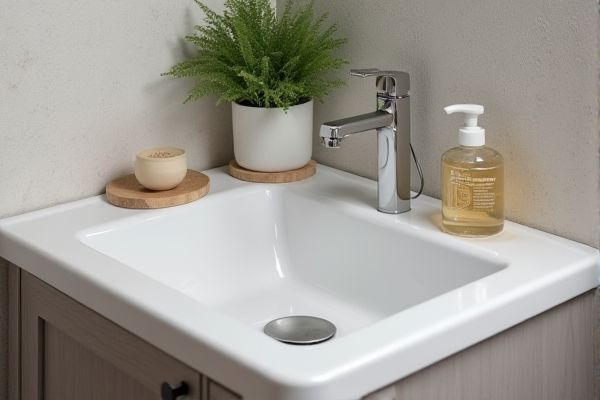
A corner sink maximizes kitchen space by fitting neatly into unused corners, making it ideal for small or oddly shaped kitchens, while a standard sink offers more traditional sizing and installation options suited for larger areas. Explore the rest of the article to understand which sink type best complements your kitchen layout and needs.
Table of Comparison
| Feature | Corner Sink | Standard Sink |
|---|---|---|
| Placement | Installed in kitchen or bathroom corner | Installed against a flat wall or countertop |
| Space Efficiency | Maximizes corner space, ideal for small areas | Requires more linear countertop space |
| Design Options | Limited styles due to shape constraints | Wide variety of shapes and sizes available |
| Installation Complexity | More complex plumbing and cabinetry work | Standard, easier installation process |
| Functionality | Often smaller basin; less capacity | Larger basins; better for heavy use |
| Cost | Typically higher due to custom fitting | Generally lower; mass-produced options |
| Cleaning & Maintenance | Harder to clean corners and edges | Easier access and cleaning |
Introduction to Corner Sinks vs Standard Sinks
Corner sinks maximize kitchen space by fitting snugly into corners, ideal for compact or uniquely shaped layouts, while standard sinks typically occupy central countertop areas offering more versatile basin sizes and styles. Your choice impacts workflow efficiency, countertop space usage, and overall kitchen design aesthetics. Understanding the functional advantages and limitations of corner versus standard sinks helps optimize both utility and visual appeal in your kitchen.
Space Utilization and Kitchen Layout
Corner sinks maximize kitchen space by utilizing often-overlooked corner areas, freeing up valuable counter and cabinet space for food prep and storage. Standard sinks typically occupy central sections of countertops, which can limit available workspace and disrupt workflow in smaller kitchens. Optimizing kitchen layout with a corner sink enhances traffic flow and creates a more efficient, ergonomic cooking environment.
Design Aesthetics and Visual Appeal
Corner sinks maximize space efficiency while offering a unique and modern design that enhances kitchen aesthetics by fitting seamlessly into unused corners. Standard sinks provide a traditional and symmetrical look, often becoming the focal point due to their central placement beneath windows or cabinets. Your choice between the two impacts the visual flow and overall appeal of your kitchen, with corner sinks promoting a sleek, contemporary vibe and standard sinks conveying classic style.
Installation Complexity and Requirements
Corner sinks require more precise measurements and customized plumbing configurations due to their placement in room corners, often demanding adjustments in existing pipe routes. Standard sinks benefit from straightforward installation processes with readily available setups designed for typical wall or cabinet placements. Your choice impacts installation time and cost, with corner sinks generally necessitating higher skilled labor and potential remodeling.
Functionality and Workflow Efficiency
Corner sinks maximize kitchen space by fitting into unused corners, enhancing workflow efficiency in smaller kitchens or open layouts. Standard sinks, typically centered along a main wall, provide ample countertop room on either side, allowing for efficient multitasking and easier integration with dishwashers or garbage disposals. Choosing between corner and standard sinks depends on kitchen size and cooking habits, with corner sinks optimizing space and standard sinks supporting streamlined cleaning and preparation tasks.
Storage Potential and Cabinet Compatibility
Corner sinks maximize storage potential by utilizing often overlooked corner spaces, making your kitchen feel more spacious and efficient. They fit well with custom or L-shaped cabinets designed with angled layouts, contrasting with standard sinks that typically require straightforward base cabinets and offer less optimized storage. Choosing a corner sink can enhance cabinet compatibility in tight kitchen corners, providing better access and organization options.
Plumbing Considerations and Maintenance
Corner sinks require specialized plumbing configurations due to their placement at room intersections, often necessitating angled pipes and customized drainage solutions to fit compact spaces. Maintenance for corner sinks can be more challenging because tight spaces limit access to valves and piping, increasing the complexity of repairs and inspections. In contrast, standard sinks usually have more straightforward plumbing with easier access for routine maintenance, making them generally more convenient for plumbing adjustments and upkeep.
Cost Comparison: Corner vs Standard Sinks
Corner sinks typically cost more than standard sinks due to their specialized design and installation requirements, with prices ranging from $150 to $500 compared to $100 to $300 for standard sinks. Installation of corner sinks may also incur higher labor costs because of the need for custom plumbing adjustments and cabinet modifications. Your choice between corner and standard sinks can impact both your upfront expenses and long-term maintenance costs depending on your kitchen layout and plumbing setup.
Pros and Cons Summary
Corner sinks maximize kitchen space by fitting into unused corners, enhancing workflow in small kitchens while offering unique aesthetic appeal. Standard sinks provide larger basins and easier access for washing multiple dishes but require more countertop space and may limit cabinet storage. Choosing between corner and standard sinks depends on kitchen layout, user needs, and spatial constraints.
Choosing the Right Sink for Your Kitchen Needs
Corner sinks maximize space efficiency by fitting neatly into unused kitchen corners, ideal for smaller or uniquely-shaped kitchens. Standard sinks offer a broader range of sizes and styles, providing more counter space flexibility and easier installation with common cabinetry. Your choice depends on kitchen layout and workflow preferences to optimize both functionality and design.
 homyna.com
homyna.com